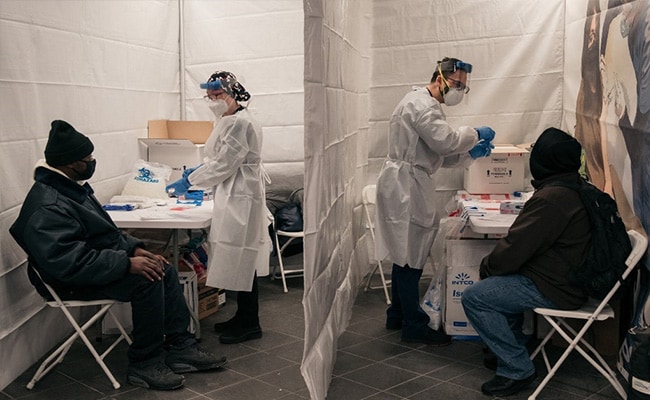
On Rebecca Roberts's medical chart, her obstetrician wrote: singleton.
Rebecca Roberts and her partner struggled with infertility for more than a year, so when they got a positive result with an at-home pregnancy test, they were overjoyed.
But the news did not feel real until the first ultrasound appointment, when the couple saw their baby on a sonogram screen and listened to the calming cadence of a steady heartbeat.
On Roberts's medical chart, her obstetrician wrote: singleton.
"I remember walking away from the very first scan so happy," said Roberts, 39, who lives in Wiltshire, England.
But her excitement abruptly shifted to shock five weeks later at the 12-week ultrasound appointment, when the sonographer spotted something astonishing: It appeared as though Roberts was suddenly carrying two babies - one of which was considerably less-developed than the other. The room fell silent.
"I thought something awful had happened," Roberts said. "The sonographer looked at me and was like, 'Do you know you're expecting twins?' "
But this was not a typical set of twins, Roberts learned. Her pregnancy was diagnosed as superfetation, a rare condition in which a woman who is already pregnant conceives another baby.
Roberts's pregnancy is one of few superfetation cases recorded in medical literature, said her obstetrician, David Walker.
Superfetation is so uncommon that Walker struggled to diagnose it. In his 25 years as an obstetrician, it was something he had never seen before.
"It just doesn't happen," Walker said, adding that it took several scans before he could confidently diagnose the condition.
"We were concerned because the second twin was much smaller. It was only by regularly scanning and seeing that the rate of growth was consistently three weeks behind that we realized it was superfetation," he explained.
The true number of superfetation cases is not known, but according to a report published in 2008 in the European Journal of Obstetrics & Gynecology and Reproductive Biology, fewer than 10 instances of the phenomenon had been recorded at the time.
Ordinarily, hormonal and physical changes during pregnancy prevent another conception from occurring. That was not the case for Roberts.
"Instead of stopping ovulation, she released another egg about three or four weeks after the first one, and the egg somehow miraculously managed to fertilize and implant in her uterus," Walker said.
Although Roberts was taking a fertility drug to stimulate ovulation, Walker said he's "not convinced" that the medication - which can increase the chances of having multiples - is what caused the superfetation.
"She didn't release two eggs at the same time, which is what the medication normally does," Walker said. "But we have no way of proving it one way or another."
While Walker was initially concerned about how the pregnancy would progress, he said, "the rate of growth for both of the babies was good, which was reassuring."
When he gave Roberts and her partner, Rhys Weaver, 43, the diagnosis, "it was a massive shock," said Roberts, who also has a 15-year-old daughter. "We went home and got straight onto Google."
Surfing the Web, she said, proved mostly futile because there is minimal research and there are few examples of successful superfetation pregnancies. The condition is so rare that alleged cases are sometimes met with cynicism.
"There is very little information, because this is not supposed to happen," Weaver said. "It was just crazy news."
Over time, though, the notion of carrying two separately conceived babies began to normalize, Roberts said. While it might not have been the pregnancy she expected, after years of longing for another child, she was thrilled to have not just one but two on the way.
Given the rarity of the condition, coupled with Roberts's age and the common risks associated with carrying twins, the pregnancy brought some challenges, particularly during the third trimester. The couple were told that the younger baby might not survive.
"Anything that can go wrong with a pregnancy is more common with twin pregnancies," Walker said. "But with a three-week difference, you don't want to compromise the smaller twin by delivering too early. You have to keep a really close eye. The delivery was crucial in this case."
Roberts knew preterm labor was probable, so ensuring that the smaller baby was far along enough before birth "was a really massive worry for us," she said.
At just over 33 weeks into the pregnancy, the smaller fetus's umbilical cord was not functioning normally, which started to affect the baby's growth. Doctors decided it was time to deliver.
Although Roberts's children had different due dates, she had a Caesarean section and gave birth to both babies on Sept. 17. Noah came first, weighing 4 pounds, 10 ounces. Two minutes later, his younger sister, Rosalie, arrived, weighing 2 pounds, 7 ounces.
"We got to see both of them as soon as they were born," Roberts said. "It was absolutely beautiful."
"One of the best feelings I've ever had," Weaver said.
The family's initial bonding time was short-lived, as both babies were whisked away to the neonatal intensive care unit. Noah remained in the hospital for just over three weeks, while Rosalie stayed for 95 days.
The couple drove to the hospital every day to visit their children until just before Christmas, when they were given the go-ahead to bring Rosalie home.
"We could finally get on and start our lives. It felt like we were on hold having them in the hospital," said Roberts, who designs children's clothing.
Taking care of twins, who are now almost 6 months old, has been a whirlwind, especially during the pandemic lockdown and while working from home. But Roberts said it has made her heart full to watch the babies grow and develop over the past few months.
"Even though they were born on the same day, there's definitely an age difference between them," she added. "It's noticeable."
Rosalie is much smaller and less advanced than her brother, "but she's catching up to him fast," said Weaver, a mortgage adviser.
Regardless of their developmental differences, the twin bond is unmistakable, the couple said.
"When we lay them down next to each other on their play mat, they look at each other, reach out and touch each other, and talk to each other as well," Roberts said. "It is so beautiful to watch."
Roberts and Weaver have been documenting the twins' growth over the past few months on an Instagram page, and thousands of people around the world, fascinated by their story, are following along.
"We want people to be able to continue to watch as they grow up," said Roberts. "Miracles can happen, and my children are proof of that."
(Except for the headline, this story has not been edited by NDTV staff and is published from a syndicated feed.)
source https://www.ndtv.com/world-news/uk-woman-gets-pregnant-while-already-pregnant-gives-birth-to-twins-2409561








Post a Comment
EmoticonClick to see the code!
To insert emoticon you must added at least one space before the code.